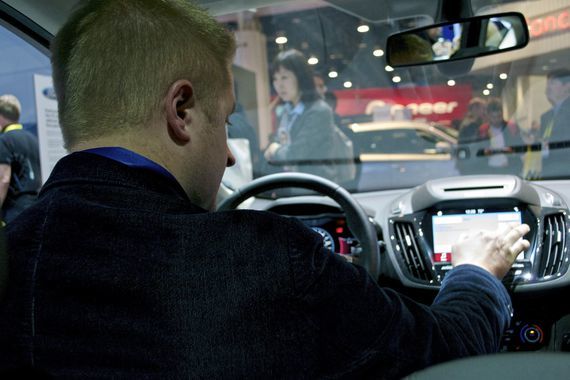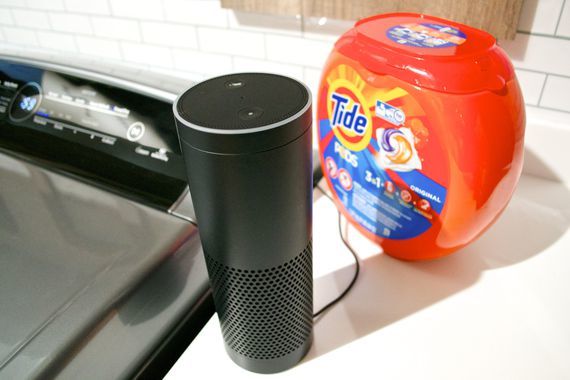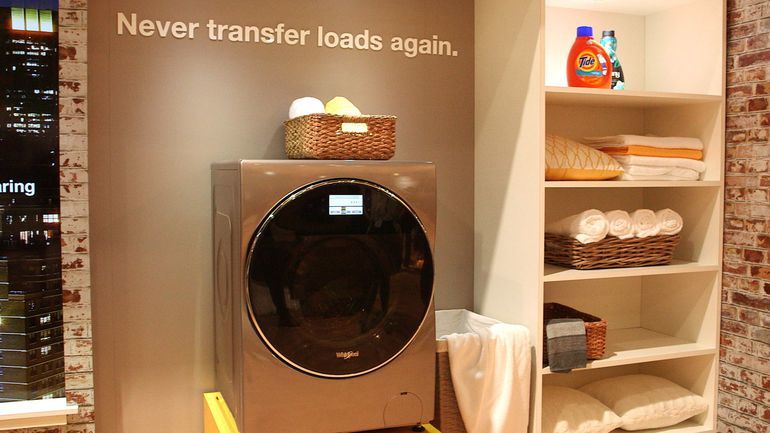In a corner of LG’s sprawling, dripping-with-technology booth at the Las Vegas Convention Center sat a circular table populated by a group of small, futuristic snowmen. Each of them sported a black touchscreen display showing a pair of electronic eyes that would intermittently squint as if they were smiling at you.
On a large screen nearby, a video showed one of these gizmos, the LG Hub Robot, calling out in a soothing tone: “Hello. I’m your personal assistant at home. I learn your lifestyle to better serve you.”
This year’s CES tech show in Las Vegas highlighted how our technology is finding its voice, with makers of cars, appliances and speakers starting to let people control their products simply by talking to them. A big catalyst for this trend is Amazon, whose Alexa voice assistant was announced as a new addition to dozens of devices at the show, including the LG robots, which are expected to go on sale this year.
At CES, people say hello to LG’s new talking robots, which can play music, read you a book or activate an LG robot vacuum.
Photo by Ben Fox Rubin/CNETAll this voice-enabled stuff points to a future in which people can interact with their devices without even having to get off the couch to grab a remote control. Adding more voice to technology could make complicated systems, like an automated home, easier to use than they’d be with a busy touch display or a remote bristling with buttons. The ubiquity of Alexa at the show — even if Amazon didn’t have a booth here — underscores the importance of these assistants, which include Apple’s Siri, Google’s Assistant and Microsoft’s Cortana.
“In the end, the assistant is going to be pervasive when you’re at work, when you’re in the car, when you’re at school, whatever it might be,” Rishi Chandra, vice president of product management for Google Home, said during a smart-home panel Thursday.
People, though, will have to weigh the positives of these digital helpers against potential drawbacks, including privacy worries about Wi-Fi-enabled microphones that are always listening for an activation word like “Alexa.” Also, making some functions too easy may cause new headaches, as proved by an intrepid 6-year-old who used an Alexa-powered Amazon speaker to buy a $160 dollhouse and sugar cookies.
More than just something to talk to


Bankowski shows off Ford’s chattier features.
Photo by Ben Fox Rubin/CNETSoon after I met the LG robots Friday, I found myself sitting in a Ford C-Max sedan parked at another section of the convention hall. There, Ford apps expert Stefan Bankowski demonstrated the car’s Alexa-powered capabilities. Hitting a microphone button on the dashboard touchscreen, he asked Alexa to play Jeopardy, tell him a joke and get him directions to the nearest Starbucks. The same friendly Alexa voice used in Amazon’s Echo speaker, the first device to use Alexa, responded to each question.
“You take the commute and enhance it. These are things you just couldn’t do before,” Bankowski said, noting that he now likes to play Jeopardy in the car on the way to work.
Integrating these features aren’t just for fun. Adding more voice functions to the car can make it safer, Bankowski added, since drivers won’t have to fumble around as much with the control panel. By summertime, all Ford and Lincoln vehicles in the US that use Ford’s Sync 3 system will get upgraded with Alexa.
Discussing another deeper value for voice assistants, Pamela Fahrendorf, a former professor from Durant, Oklahoma, visiting the show, said she could use a voice assistant to ease some of the physical difficulties she has from Parkinson’s Disease.
“My fingers don’t always work as well,” she explained.
Keeping up the conversation
At Dish’s booth, I went into a glass-enclosed room, where a spokeswoman told an Amazon Echo Dot speaker to change the channel on a TV to the Cooking Channel. “Tuning to the Cooking Channel, showing ‘Pizza Masters,'” Alexa responded.
The Alexa integration with Dish‘s Hopper 3 set-top box, available by midyear, can also let people search for movies by genre or actor, skills the Apple TV already has using Siri.


A Whirlpool Cabrio dryer will soon be able to connect with an Amazon Echo to start, stop or pause cycles.
Photo by Ben Fox Rubin/CNETAt the Sands center, Whirlpool internet of things designer Mike Jakeway explained how Alexa will be able to control the company’s new washers, dryers, ovens and refrigerators, with the features rolling out sometime this year. Need to preheat the oven? Just ask your Echo. Want to check how much time is left on the wash in the basement? Alexa will know that one, too.
“It’s all about taking friction out of people’s lives,” Jakeway said, standing by a washer and dryer set next to an Echo speaker at the Whirlpool booth.
Mike George, Amazon’s vice president of Alexa, told me Thursday that his company is working on teaching Alexa to become more conversational, allowing people to talk more naturally to the assistant instead of using it just for quick, one-off voice commands.
“She will become smarter and use that information to have much more natural interactions with you,” he said.
While Alexa has taken a clear lead in voice partnerships, we’re still in the early stages of creating chatty devices. That means Amazon, Google, Apple and others will have to keep pushing to convince customers these features will make their lives easier, not just filled with more technology.
“If people can get more control and offload some of the mundane hassles of daily life,” John Curran, an Accenture senior executive, said ahead of the show, “I think they’re going to be thrilled, and I see that as a real potential for growth.”
